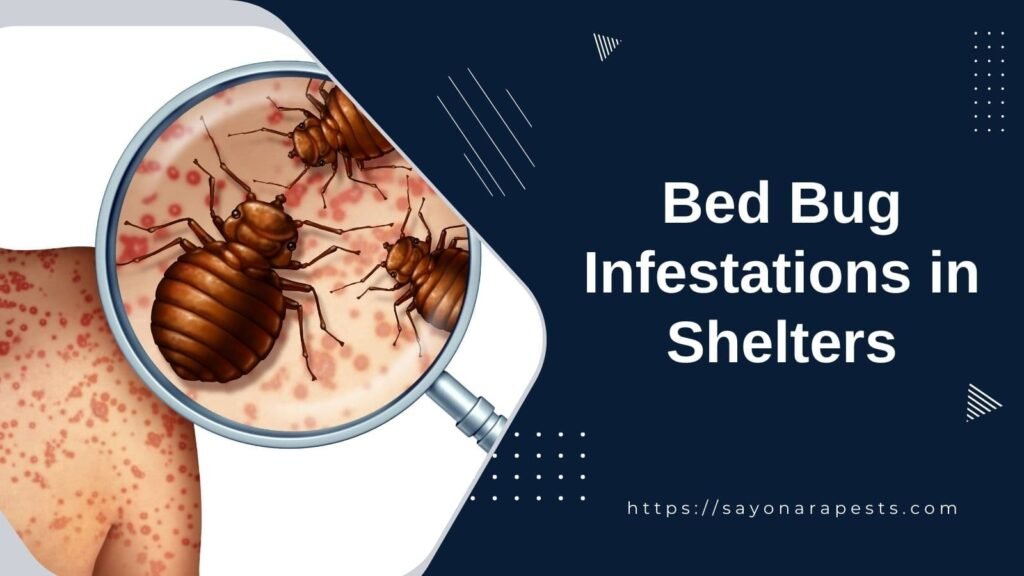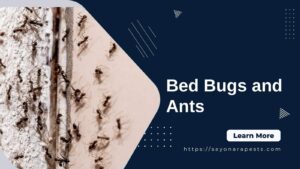Identifying Bed Bug Infestations
The first step to combating bed bug infestations in shelters, or any location for that matter, is accurately identifying the presence of these pests.
Understanding where to look and how to collect evidence are essential components in beginning the eradication process.
Locating the Infestation
Bed bugs are skilled at remaining undetected, often hiding in areas close to human activity.
To locate an infestation, one must scrutinize common hiding spots, which include seams of mattresses, box springs, bed frames, and headboards.
However, these pests can also seclude themselves behind baseboards, wallpaper, upholstery, and in furniture crevices.
When inspecting for bed bugs in a shelter or similar communal living space, it’s crucial to note their location as specifically as possible.
This detailed information is vital whether you’re responding independently or enlisting the aid of a professional pest management company. ZappBug emphasizes the importance of this step in evaluating the extent of the infestation.
Collecting Samples
Confirming a bed bug infestation requires collecting at least one live sample of the insect.
Using tools like gloves, tweezers, and small containers or plastic bags can aid in capturing these elusive pests. Residents should be encouraged to report sightings immediately, and staff should be trained to respond quickly to prevent the spread.
Once collected, samples should be carefully examined to distinguish bed bugs from other insects.
Characteristics to look for include a reddish-brown color, an oval-shaped body, and a size of about 4 to 5 millimeters long. Proper identification is imperative in choosing the most effective treatment methods.
In shelters, where swift action can prevent a larger outbreak, the immediate containment of suspected items is recommended.
Measures such as sealing bedding and belongings in trash bags and treating them with heat are advised to address the infestation effectively.
For more information on heat treatment and other eradication methods, visit our articles on killing bed bugs with heat and using steam to kill bed bugs.
Containment and Prevention
Containing and preventing the spread of bed bugs is a critical step in managing infestations, especially in communal living spaces like shelters.
Implementing effective strategies can significantly reduce the proliferation of these pests and minimize the impact on residents.
Bagging Bedding and Belongings
One of the initial containment measures is to bag bedding, clothes, and personal belongings. The ZappBug guide suggests using large trash bags to seal items tightly, which helps to contain and isolate any bed bugs present.
In shelters, residents should be encouraged to bag their belongings as a precautionary measure to prevent the spread of the infestation to new areas.
After bagging, the items should be treated with heat as promptly as possible. This step not only contains the bed bugs but also prepares the items for the next phase of extermination—heat treatment.
Heat Treatment
Heat treatment is a powerful tool in the battle against bed bugs. Exposing infested items to temperatures above 120 ℉ (50 ℃) has been proven to kill bed bugs within minutes. Methods such as using a heat chamber or placing items in a dryer on high heat are both effective approaches.
After the heat treatment, a thorough wash and drying cycle ensures the complete elimination of the pests. The table below outlines a simple guideline for the heat treatment process:
| Step | Temperature | Duration |
|---|---|---|
| Heat Treatment | 120 ℉ (50 ℃) or higher | Until all items reach the target temperature |
| Washing | Follow garment care labels | – |
| Drying | High heat | At least 30 minutes after items are dry |
For individuals managing shelters or communal living spaces, it’s essential to have a protocol in place for killing bed bugs with heat.
Additionally, educating residents about preventing bed bugs when traveling and how to check for bed bugs in hotel rooms can further aid in preventing the introduction and spread of infestations.
By diligently bagging belongings and employing heat treatments, shelters can create an effective defense against bed bug infestations.
Regular monitoring and maintenance, coupled with these preventative measures, contribute to a comprehensive strategy for managing and ultimately defeating bed bugs in shared living environments.
Thorough Inspection
A meticulous inspection is a cornerstone in identifying and managing bed bug infestations.
This process involves a careful examination of areas where bed bugs are likely to hide and considering the layout of the room which might influence the extent of an infestation.
Checking Common Hiding Spots
Bed bugs are adept at concealing themselves in small cracks and crevices close to human environments. When inspecting for bed bugs, it’s vital to check their common hiding spots, which include but are not limited to:
- Seams of mattresses and box springs
- Cracks in bed frames and headboards
- Joints of drawers and furniture
- Behind baseboards and electrical outlet covers
- Underneath loose wallpaper and wall hangings
- Along the edges of carpets and between floorboards
Given their preference for wood, paper, and fabric, bed bugs often reside in the seams of wallpaper, molding, and behind switchplates.
They are also found in the coils of mattresses, behind pictures, and in any clutter near sleeping areas. Utilizing a flashlight and a magnifying glass can aid in spotting these elusive pests.
For additional information on common bed bug hiding spots, ZappBug provides a comprehensive guide.
Room Layout Considerations
The layout of a room can greatly affect the spread of bed bugs. These insects can crawl short distances and move to adjoining rooms or even across different floors.
In multi-unit settings, such as apartment complexes, bed bugs can traverse between units both vertically and horizontally.
It’s not uncommon for them to hitchhike on objects like furniture, bedding, or packaging materials, which facilitates their spread to new locations.
Travel is another significant factor in the spread of bed bugs.
They can latch onto clothing, luggage, and personal items, making hotels and other temporary accommodations hotspots for picking up these pests. If you’re a traveler, it’s wise to learn how to check for bed bugs in hotel rooms.
During an inspection, it’s important to consider the potential for bed bugs to infest adjacent rooms and to inspect any item that may serve as a vehicle for their movement.
Understanding their behavior and movement patterns is crucial in preventing further spread and achieving effective control.
For insights on preventing bed bugs from spreading, explore preventing bed bugs from spreading.
Thorough inspections are key in the early detection of bed bug infestations, which is essential for effective management and control. Knowing where to look and considering the room’s layout can help in devising a strategic approach to eliminate these pests successfully.
For more details on eradication methods, visit ways to kill bed bugs.
Professional Treatment
For any bed bug infestations in shelters or homes, professional treatment is often the most reliable way to ensure complete eradication.
Professionals have access to a range of tools and techniques that are not available to the general public.
Residual Chemical Use
Professional pest control companies frequently incorporate the use of residual chemicals in their treatment protocols. These substances offer lingering protection against pests that may venture back into the area post-treatment.
The effectiveness of these chemicals can vary depending on the product and the application method, so it is crucial to entrust the process to experts who can select and deploy chemicals for maximum impact.
One common type of residual chemical used are pyrethrins and pyrethroids, which act swiftly to knock down bed bugs but may not provide extensive long-term control.
Pyrethrins are derived from plants in the genus chrysanthemum, while pyrethroids are synthetic variants designed to be more potent against bed bugs and can also act as a repellent.
Nonetheless, there is a growing concern over bed bugs developing resistance to these compounds, making it imperative to use them judiciously and in combination with other control methods.
Selecting Effective Treatments
Choosing the most effective treatment for bed bug eradication is not a one-size-fits-all situation. Professional exterminators, experienced with bed bugs, generally employ chemical treatments with pesticides that have been approved by the Environmental Protection Agency.
The selection of an appropriate treatment plan should be tailored to the specific infestation, considering factors such as the size of the infestation, the location, and the presence of sensitive populations like children or the elderly (WebMD).
In addition to chemical treatments, professionals may use a combination of methods such as heat treatments, steam, and diatomaceous earth for a more comprehensive approach.
These methods can be particularly effective when integrated into a multi-faceted plan, often referred to as Integrated Pest Management (IPM).
Here is a summary of professional treatment options and considerations:
| Treatment Type | Considerations |
|---|---|
| Chemical (Pesticides) | EPA approval, resistance concerns |
| Heat | Even distribution, temperature control |
| Steam | Surface treatment, limited penetration |
| Diatomaceous Earth | Natural, mechanical action |
For more detailed information on the various professional treatment options available, including their advantages and limitations, individuals and organizations can explore articles on effective bed bug extermination methods and best bed bug elimination techniques.
It’s also advisable to familiarize oneself with natural remedies for killing bed bugs and diy bed bug control methods as complementary practices to professional interventions.
Bed Bug Infestations in Shelters
Shelters provide a crucial service to communities, offering refuge to those in need. However, these communal settings are also vulnerable to bed bug infestations, which can be particularly challenging and expensive to address.
Cost of Control Efforts
The financial burden of combating bed bug infestations in shelters can be substantial. A study featured in Emerging Infectious Diseases reports that the cost incurred for bed bug control efforts at affected shelters can range from $150 to $15,000, with an average cost of $3,085 per affected shelter.
This significant variance in cost is attributed to the extent of the infestation, the size of the facility, and the methods of eradication employed.
| Cost Range | Average Cost per Shelter |
|---|---|
| $150 to $15,000 | $3,085 |
These figures underscore the importance of early detection and regular maintenance to prevent infestations from reaching a level that incurs such high costs. It’s also crucial for shelters to invest in effective and sustainable bed bug elimination techniques to manage costs while ensuring the safety and comfort of residents.
Challenges in Communal Settings
The communal nature of shelters presents unique challenges in managing and eradicating bed bug infestations. Close quarters and high turnover rates can facilitate the rapid spread of bed bugs.
Additionally, the high mean number of pest control treatments required per affected location, as indicated in the same study by Emerging Infectious Diseases, suggests that standard eradication methods may be less effective in these environments.
In shelters, it’s vital to implement a comprehensive and ongoing pest management strategy that includes heat treatments, vacuuming, and the use of insecticides.
Additionally, educating residents about preventing bed bugs when traveling and how to check for bed bugs in various locations can help in reducing the risk of new infestations.
Shelters must also consider the psychological impact on residents and address the common misconceptions about bed bugs to prevent stigma and anxiety.
By fostering an environment of awareness and proactive management, shelters can better protect their residents and maintain a bed bug-free setting.
Other Infested Locations
While bed bug infestations in shelters present unique challenges, these pests are not confined to communal living spaces.
Understanding common infestation areas and ways of transfer is key to preventing and controlling the spread of bed bugs.
Common Infestation Areas
Bed bugs are notorious for their ability to thrive in various environments. They are not just a concern for homeowners and renters but also for businesses and public spaces.
According to WebMD, bed bugs can live in hotels, apartments, furniture, cruise ships, buses, trains, and more. These pests prefer to live on surfaces like wood, paper, and fabric but can adapt to stone, metal, and plaster if necessary.
Typical hiding spots in infested locations include:
- Seams of mattresses
- Inside mattress coils
- Cracks in bed frames and bedside furniture
- Dressers and wallboards
- Door and window frames
- Behind pictures and under loose wallpaper
These critters are particularly adept at stowing away in areas near where people sleep, which can include a wide range of establishments such as hotels, libraries, restaurants, laundromats, and campgrounds.
Ways of Transfer
Bed bugs are master hitchhikers. They can crawl short distances to infest other rooms in a house or business, and in apartment buildings, they can move from one unit to another both vertically and horizontally.
Long-distance transfers often occur when infested objects such as bedding, furniture, or packing materials are relocated.
Travel is another significant factor in the spread of bed bugs. Travelers can unwittingly transport these pests in clothing, luggage, and electronic device cases.
This is why it’s crucial to practice preventing bed bugs when traveling and to stay vigilant when staying in hotels or using public transport.
To mitigate the risk of transferring bed bugs, consider the following steps:
- Regularly inspect luggage and clothing after travel
- Avoid placing bags on beds or upholstered furniture in hotels
- Use protective covers for mattresses and box springs
- Be cautious when acquiring second-hand furniture
- Regularly vacuuming living spaces and inspecting for signs of bed bugs
Understanding the common infestation areas and ways of transfer is essential for preventing bed bugs from spreading and maintaining bed bug-free environments.
Whether you’re a homeowner, hotelier, or someone managing a communal space, awareness and proactive measures are the best defense against these persistent pests.



